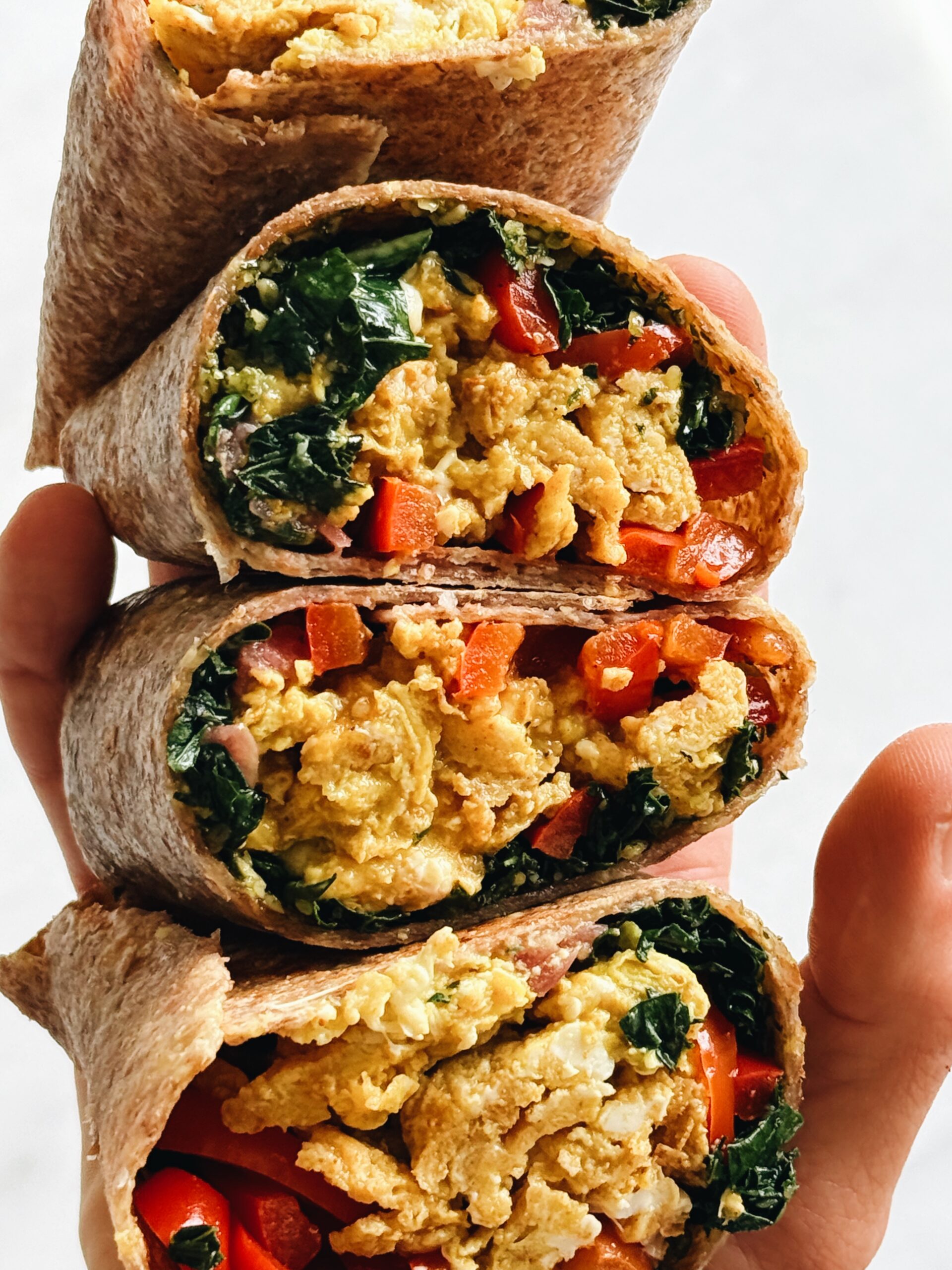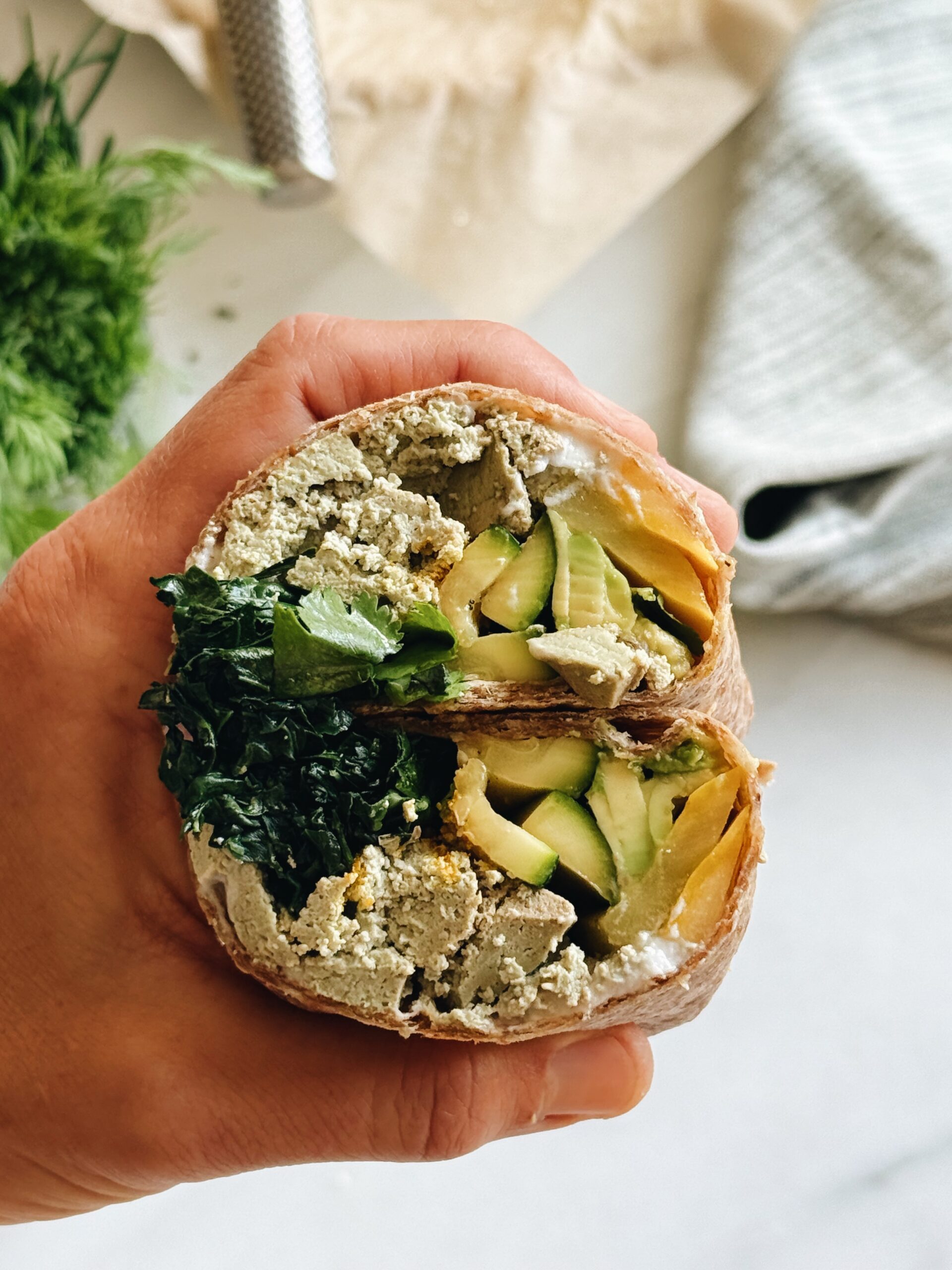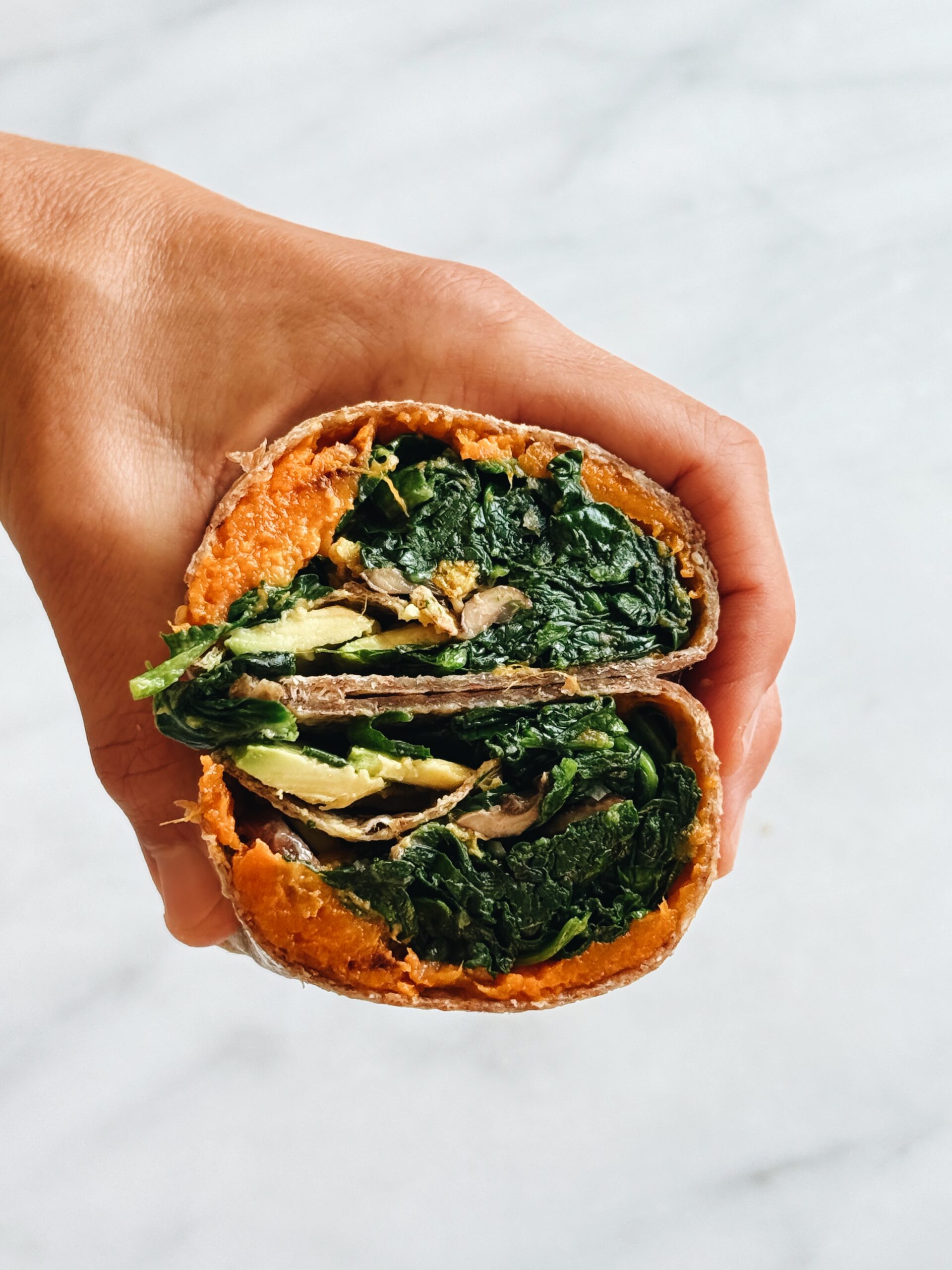

Truly bomb burritos that won’t be bombs for your gut.
Let’s just start by saying: it’s not my intention to burst your bubble on breakfast burritos here, but it IS my intention to point out that there’s a very strong chance that the one that you often eat (and then have digestive distress after) isn’t serving you that well. BUT! Best news! There is a way to make a breakfast burrito that WILL serve you well…and I’m going to tell you how to do just that, below.
As if you didn’t know this already, not all breakfast burritos are created equally. And I’m not just talking about “bad,” and “better” ones. I’m talking about a burrito crafted to suit your constitution, and one that is sadly not crafted to suit your constitution. If you’ve ever had a gurgly belly, or had to poop your brains out right after eating one, you know what I’m talking about. If having an urgent and soul-emptying trip to the toilet is something that you look forward to (or heaven forbid, something that you feel you need) then you may want to stop reading right here. But if you, like me, enjoy eating all the things and want them to feel good, fuel good, bring the joy AND benefit then keep on reading.

A few things. The first, proteins are not only expensive, but also really challenging to digest. And so when we pile on meat AND beans AND dairy products we basically do the equivalent of your boss dropping a massive spreadsheet project on your desk, requiring you to sort through hundreds of thousands of data points, without using AI, or coffee, and telling you it has to be done by tomorrow so that you can tackle the next massive task they have planned. Not even kind of, it’s EXACTLY like that because regardless of what you ate for dinner last night, you WILL go hit it hard tomorrow, won’t you? I thought so.
Secondly, most of us don’t live in environments where we’re that worried about parasites on a consistent basis. So the multitudes of spice and sourness woven into most tacos or burritos is not only applicable to our life circumstances (ie: our bodies don’t need this) but most of our systems don’t want this level of acidity. Instead, we’re living such hectic lives, we’re having a hard time getting anything to live in our guts. We need to cool down our systems so that we can have healthy microbiome activity. And all the spice is really upsetting that lil project.
And that’s a great place to start.
Now hang on – there are no “good foods” and “bad foods” in Ayurveda, though there are definitely foods that will serve us better than others. Eating a breakfast burrito every once in a while isn’t a bad thing. But even better is finding a way to make yourself a breakfast burrito that will serve your constitution well.

While the general needs of a human digestive system are the same, (ie: everyone’s belly is happier when we don’t eat beans, meat, and dairy together) the individual needs of our prakruti (or individual doshic constitution) has it’s own definition of what’s healthy, balancing…good.
To speak to this, let’s address the substantial differences between the three doshas — Vata, Pitta + Kapha.
Vata dosha is…
Comprised of ether + air. Individuals with the highest amount of vata dosha in their constitutions are typically creative, free-thinking, spontaneous. They don’t typically have a lot of “systems” or structure in their lives, and they like it this way. Their body types are typically thin, lithe, often tall, and they’re prone to digestive conditions because the seat of vata is in the colon, and their bodies are already quite cold. Add to this that vatas love to move, and so they actually are creating more wind/coolness in their lives with all the shaking + doing. The qualities of this dosha are cold, rough, dry, mobile and subtle, and these individuals benefit by foods/practices that emphasize warm, smooth, moist, grounding + dense qualities (the opposites.)
Pitta dosha is…
Comprised of fire + water. Individuals with the highest amount of pitta dosha in their constitutions are typically focused, driven, high-achieving and intense. They love structure, love goal setting, and love the process of achieving their goal. They thrive on being able to check things off their to do list, and they will stop at nothing (not even inconvenience or personal discomfort) to get that personal pat on the back. Structure is the way pitta loves to live, and they start to become edgy when things don’t follow their design. Their body types are typically strong and sturdy, and they’re also prone to digestive conditions because the seat of pitta is in the stomach, and they’re already quite “firey,” not to mention that the intensity they bring to the world creates a bit of fire. The qualities of this dosha are hot, sharp, oily, light, pungent, sour, spreading and liquid. And, these individuals are benefitted by emphasizing the opposite qualities in their foods + lifestyles: cool, mild, heavy, dry, sweet, bitter + astringent.
Kapha dosha is…
Comprised of water + earth. Individuals with the highest amount of kapha dosha in their constitutions are typically stable, consistent, slow acting, methodical, stoic thinkers who require structure, stability and calm-collectedness to function. They thrive on long projects, deep thoughts, efforts of endurance and loyalty, and are highly annoyed or disoriented when things change, move or flow too quickly or too often. Deep thinkers, and those recognized for lifetime achievements are often high in kapha. Their body types are typically dense, strong and sometimes on the extra muscular side, and they’re prone to inactivity or a sense of the sedentary because the home of kapha in the body is behind the heart and lung space (which also makes them prone to heartache and breathing issues.) The qualities of this dosha are heavy, slow, cold, oily, smooth, dense, soft, stable and cloudy and so they’re well served by the opposites: light, sharp, hot, dry, rough, subtle, mobile, clear — all of which help to shake up, envigorate and enliven individuals of this dosha.

Just by reading these descriptions, I hope you can hear just how the oily, spicy, hot, and dense qualities of most of our tex-mex cuisine (specifically tacos + burritos) aren’t of service for athletic constitutions. If we were all working on our dissertations about the mathematics of tacos instead of eating them to fuel our intense athletic goals, maybe these foods would be a better choice. But as it is, we have a little focused redesigning to do.
Bottom line:
All constitutions benefit from choosing one protein – beans, meat or cheese – and leaving the others by the wayside.
If you’re a vata, spice might be fine. But combining proteins will be extra hard on your body. So too will focusing on veggie tacos, especially if the beans have been improperly prepared (newsflash: if you’re eating at a restaurant, 99% chance they have taken a shortcut that will make you feel like a huge fart.) Same with raw slaws – steer clear. BUT, avocado is your ally. Make it a double.
If you’re a pitta, pungent spices and salsa aren’t your friend. Super sour and salty isn’t either. Proceed into burritoland with caution, and awareness (that ultimately leads to joy.) The good news is that you can use avocado with reckless abandon. I consider this a massive win.
If you’re a kapha, spice is your friend but you’re gonna hold the guac. And maybe the meat too. Definitely the cheese. But we can still make a very tasty little burrito for you.
There are a few key ingredients worth examining as you’re “redesigning” your taco/burrito order. I addressed them lightly above, but let’s dive in here:
Salsa/Hot Sauce
Time and time again, I have clients surprised to hear that they would feel better if they would consider removing hot sauce, jalapenos, salsa and the like from their diets.
“But I’ve always eaten it this way!”
“It doesn’t taste like much when I take off the spice!”
I’m sure you have, and I’m sure this is your initial response to the flavor profile…because the high pitta in your system is raging so hard that it wants to feed it’s own fire. You’ll feel much better in your body + your life if you cut back and use spice smartly, instead of as a blanket.
These hot components are excellent for constitutions that are cold in nature (kapha + vata) but if you’re a pitta, I strongly recommend rethinking this add.
Instead of folding hot sauce, salsa or jalapeno into your burrito, I suggest weaving spice into the preparation itself: sprinkling ground cumin into the sauce, or turmeric into the eggs. Putting cinnamon in the cooking liquid for your beans. These are smart, manageable additions of spice that won’t liquify your bowels (sorry, but it’s true.)
Proteins
This is a factor of Ayurvedic nutritional wisdom that is often overlooked by those used to thinking about macros. The proteins we have to choose from also have different qualities, some heavier, more oily, and others more light. Eggs and meat are considered to be “dense” in Ayurvedic wisdom, and therefore more suitable for vata and pitta constitutions that need a little weight, without being “heavy.” Legumes and plant-based proteins are the lightest on offer, and these are best suited to kapha types. Where do beef and pork weigh in? These are heavier, oilier and more dense proteins that are helpful for vata and pitta in extreme moderation, or in the heavier months when metabolism revs and we require more dense nutrition.
Dairy
This is a really interesting component that almost no constitution benefits from in the context of breakfast burritos, assuming that there are other proteins at play and that you’re eating your burrito first thing in the morning. If you’re a pitta, or a vata and you want to have a cheese burrito, do it up! (This is less recommended for kaphas.) But Ayurveda wouldn’t recommend adding cheese or sour cream here because they’re cold, challenging to digest, and don’t positively benefit your digestive experience. I, too, love a little something creamy on my tacos, so you’ll see that I suggest making a coconut yogurt crema that we use ad nauseum in our tex-mex meals here at home. Instead of clogging up the digestive system, this ingredient cools and soothes, making it a more sensible for me to build with spice.
Avocado
The great news is that, if you’re reading this, chances are that avocado is a SUPER helpful ingredient for cooling, nourishing and balancing your body. The exception to this rule is if you are a kapha constitution OR if you’ve been having sluggish digestion of late. If your digestion is heavy, avocados are only going to further cool and slow the system. Something to think about before you spend the extra 25 cents, right.

Alright, enough talk – let’s cook.
In the recipe below, you’ll see individual instructions for how to build a breakfast burrito for your constitution.
Note that what you’ll find below is not “the end-all-be-all-ultimate breakfast burrito for each dosha.” Reason is, this would require a ton of massively different ingredients, some of them far flung or fussy, and what I want to do here is give you a quick, low-lift way of looking at this type of cuisine so it will work for you (instead of discouraging you.) I’ve tried to keep the ingredients and the components slim enough that you could make them for individual constitutions, and can see the different ways to tweak ingredients for each dosha. SO! There will be ways to tweak!
And one last important note and that is: if you’re honoring your digestion, and eating to help it thrive most of the time, know that it’s not necessary for you to ALWAYS avoid the hot sauce, or the avocado, or the sour cream, or whatever it is that you LOVE putting on your tacos. But, following this blueprint might reveal for you is that eating in a new way can open up doors to feel better, more like yourself. And that, in my experience, is worth the switch.
Great question! First, I’d start with taking the dosha quiz.
This quiz is a great place to start better understanding your doshic constitution (your prakruti – or innate state of being, in Ayurvedic medicine.) That said, our bodies and beings are CONSTANTLY under the influence of other doshas in our lives. Because the doshas are in the foods we eat, the experiences we have, the weather in nature, and doshic qualities even apply to times of day, times of the month, our thoughts and our emotions, depending on how we’re living our lives, and what we’re eating we are likely to be out of balance with our innate state of being. This is what we call our vikruti in Ayurveda, or our present state of being. The goal of Ayurvedic medicine is to pull our present state of being as close to our innate state of being as possible – we want our vikruti to closely match our prakruti whenever possible. This is the reason to adjust our foods, our routines, our practices, and our performance efforts to suit our doshas. Working with an Ayurvedic practitioner can help with this – we can fine tune so much more than your oatmeal!
Once you know your dosha, choose the recipe that matches that dosha. The recipe will help you to finely tune your breakfast burrito to your being!
That's ok, just sign up or log in to see this recipe.